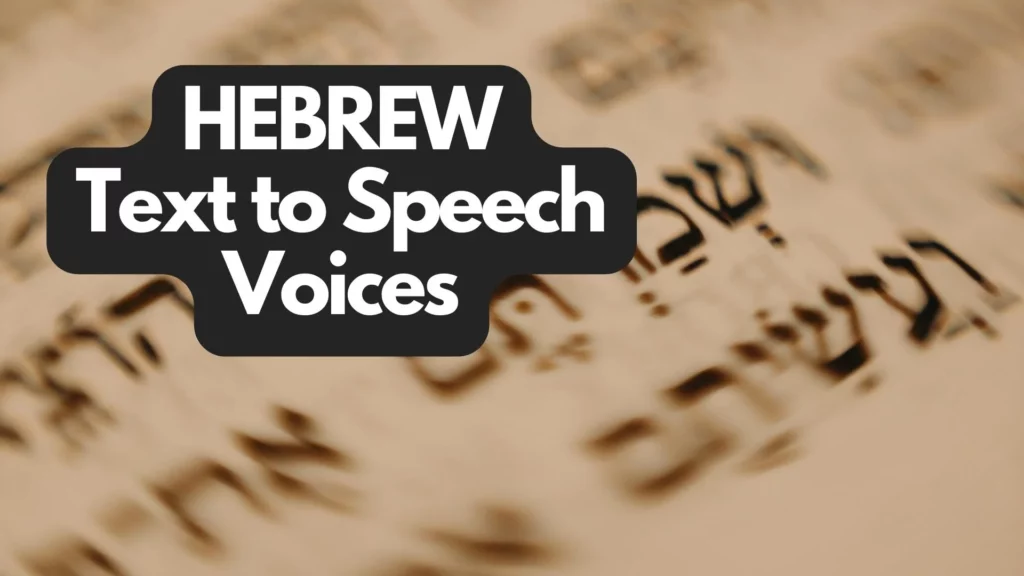Text to speech (TTS) software is a transformative tool that changes written text to spoken words. It enables digital devices and applications to communicate with us. TTS has many uses, including improving accessibility for those who are blind. It is a technology sector that is always developing and offering us opportunities for communication.
Understanding Hebrew Text to Speech (TTS)
Text-to-speech (TTS) is a technology that converts written text into spoken language. It’s a system designed to produce synthetic speech that humans can hear. Text to speech technology converts written text into spoken words. TTS grows amazing over time, making it a valuable tool for anyone with different language requirements. Let’s explore the core of this wonderful invention with a focus on Hebrew TTS.

Features of Hebrew Text to Speech
Modern Hebrew Text-to-Speech (TTS) systems offer a range of features and capabilities to improve their appeal and speed. These features make Hebrew Text to Speech a valuable tool for different uses. Here are some of the key features of Hebrew Text to Speech:
1. Pronunciation Accuracy: Hebrew TTS systems allow users to pronounce Hebrew words and phrases. It includes difficult sounds or unique pronunciation. They take into account exact vowel markings and diacritics.
2. Natural Intonation: Advanced Hebrew TTS systems incorporate natural intonation patterns. The entire listening experience gets better with it.
3. Multiple Voices: Many Hebrew TTS tools offer a variety of voice options, different male and female voices. This customization can suit different preferences and applications.
4. Emotional Expression: Some Hebrew TTS systems are capable of conveying emotions in speech. This feature allows the generated audio to express happiness, sadness, excitement, or other emotions.
5. Customization: Users may have the option to customize certain aspects of the TTS voices, such as pitch, speed, and volume. This customization can help tailor the speech output to specific needs.
6. Multilingual Support: Hebrew TTS systems can often handle many languages and accents. This is especially valuable in regions where Hebrew is spoken alongside other languages.
7. Dialect Handling: Hebrew has various dialects and regional variations. Modern TTS systems are designed to handle these differences, ensuring accurate pronunciation.
8. Proper Noun Recognition: Hebrew TTS systems become stronger in pronouncing words correctly. They include names, places, and proper nouns, that improve the technology’s overall accuracy and usefulness.
9. Accessibility Features: Many Hebrew TTS tools are integrated with accessibility features. This ensures that individuals with visual impairments can access written content.
10. Real-Time Translation: Some Hebrew TTS systems can translate and read the text in real-time. This feature aids in cross-language communication and understanding.
11. Voice Cloning: In some cases, users can create personalized TTS voices based on their own speech patterns. This is useful for content creators, educators, and individuals who want to use their own voice in TTS applications.
12. Ethical and Privacy Considerations: Responsible Hebrew TTS systems consider ethical and privacy concerns. The application of the technology protects user privacy and complies with ethical guidelines.
Overview of Hebrew Text to Speech Options
There are several choices available when it comes to selecting the best Hebrew Text to Speech technology. It’s important to assess these solutions on requirements about quality, cost, and accessibility. Moreover, free Hebrew Text to Speech tools are available if you’re looking for a cost-effective solution. Below is an overview of some of the Hebrew Text to Speech options available:
- Google Text-to-Speech
- Speech Hebrew TTS
- ReadSpeaker
- Natural Reader
- Amazon Polly
- IBM Watson Text to Speech
- Microsoft Azure Cognitive Services Text to Speech
- ResponsiveVoice
- Nuance Communications
- Open Source Solutions
Challenges and Limitations of Hebrew Text to Speech Free
While Hebrew Text to Speech has come a long way, it has challenges. English to hebrew text to speech technology has made significant advancements at the time. But, it still faces challenges and limitations that impact its usability and effectiveness. This tool helps us appreciate the progress made by Understanding these limitations. Here are some of the key issues:
- Pronunciation Accuracy: While Hebrew TTS has come a long way, it can still need help accurately pronouncing certain words. It can affect the comprehensibility of the generated speech.
- Emotional Expression: Hebrew TTS cannot often convey emotions effectively. Human speech consists of words as well as pronunciation, feelings, and voice. Which can be difficult for TTS systems to accurately imitate.
- Proper Noun Handling: Hebrew TTS systems may encounter difficulties correctly pronouncing names, places, and proper nouns. This limitation can be particularly problematic when using TTS for content that includes names or specialized terminology.
- Naturalness: Although improvement is done, Hebrew TTS’s simplicity can still be improved. It continues to be to duplicate the flow and tone of human speech.

Areas Where Improvements are Needed
Hebrew TTS technology should continue to develop and improve in many areas to solve these difficulties:
- Data and Training: The reliability and simplicity of generating voice can be greatly improved by expanding the training data set with a range of Hebrew sounds, languages, and feelings.
- Emotional TTS: Research into emotional TTS technology will enable Hebrew TTS systems. They work better for communications and applications to allow for a larger spectrum of feelings.
- Name Recognition: Improving the recognition and pronunciation of names and proper nouns. Hebrew is vital for improving the trustworthiness and use of TTS systems.
- Customization: Let TTS voice modification and pronunciation options be available to users. It might boost Hebrew TTS’s usefulness.
- User Feedback: Hebrew TTS systems are able to be improved to better meet the needs of the target audience. Regular interaction with users and feedback may help in identifying specific issues.
- Multilingual Integration: Hebrew TTS can be flexible due to cooperation with other languages. It happens if there are a variety of language traditions.
- Ethical and Privacy Considerations: As TTS technology evolves, addressing ethical concerns and ensuring user privacy becomes important. Guidelines for responsible user rules are needed.
Conclusion:
This in-depth analysis of Text-to-Speech (TTS) technology takes us on an interesting exploration of the exciting area where written words are translated into spoken. The article addressed the fundamental concepts of TTS, its various applications, and some upcoming trends.
TTS continues to grow vital in several areas, such as virtual assistants, GPS systems, education, and multimedia development. TTS has become an important link that unites people with various linguistic requirements.
As we conclude our journey through the realm of TTS, remember that the key to breaking down language barriers lies at your fingertips.
